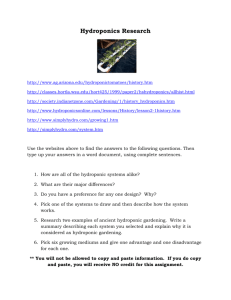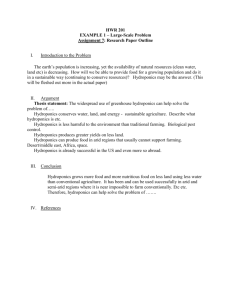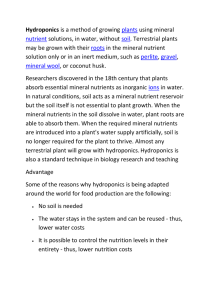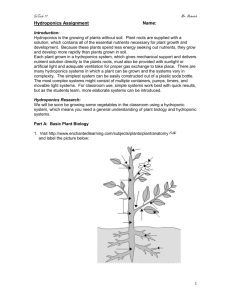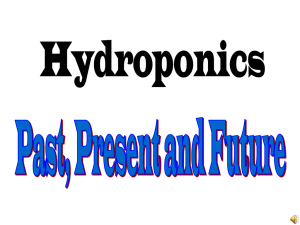growth characteristics of pechay
advertisement
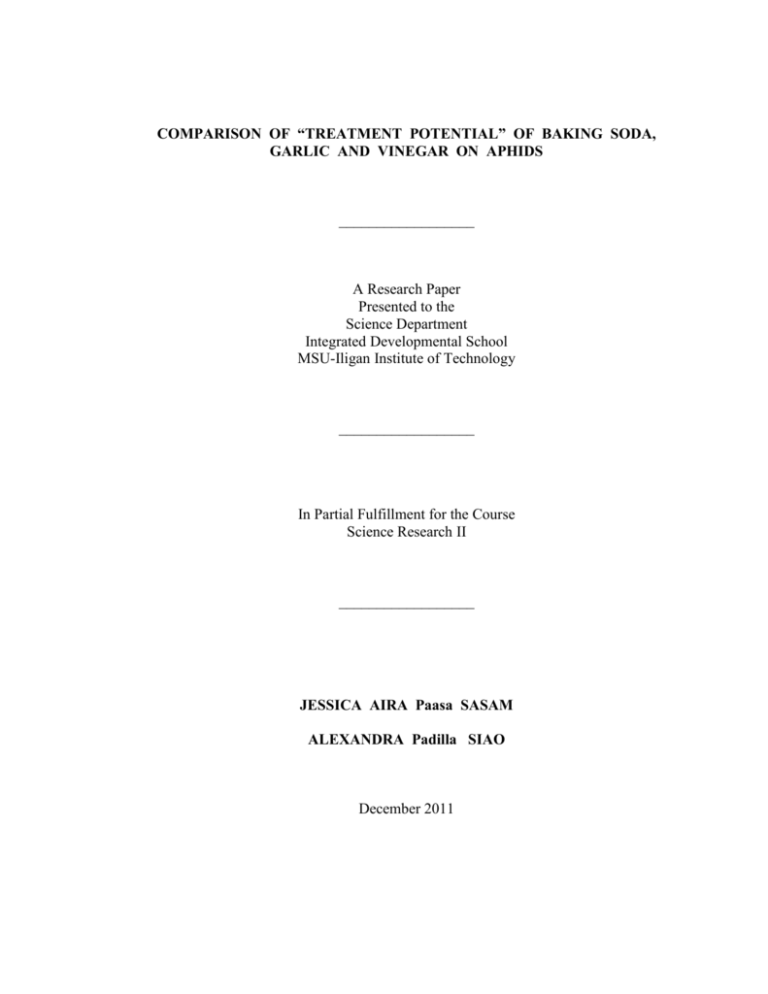
COMPARISON OF “TREATMENT POTENTIAL” OF BAKING SODA, GARLIC AND VINEGAR ON APHIDS __________________ A Research Paper Presented to the Science Department Integrated Developmental School MSU-Iligan Institute of Technology __________________ In Partial Fulfillment for the Course Science Research II __________________ JESSICA AIRA Paasa SASAM ALEXANDRA Padilla SIAO December 2011 2 APPROVAL SHEET This research paper entitled “COMPARISON OF “TREATMENT POTENTIAL” OF BAKING SODA, GARLIC AND VINEGAR ON APHIDS” prepared and submitted by JESSICA AIRA Paasa SASAM and ALEXANDRA Padilla SIAO PROF. CHARITY I. MULIG Adviser ________________ Date MS. ALMA GLORIA L. SILVA Panel Member PROF. VICTORIA A. TARRANZA Panel Member ____________ Date ____________ Date Accepted and approved in partial fulfillment of the Course in Science Research I. PROF. VICTORIA A. TARRANZA Chairperson, Department of Science and Mathematics Date PROF. LEILA V. BERNALDEZ Principal, IDS Date 3 CHAPTER 1 INTRODUCTION A. Background of the Study Most of the land available for growing plants, especially in urban areas, is now being turned into construction sites for buildings and other infrastructure. Even though this is true, rate of food production can still be maintained through soilless farming. Hydroponics could be the solution to problems like lack of food and also, through this, the beautification of urban areas, where plants cannot be found because there is no soil, may be possible. Although the method itself is not new, there are still people who are not familiar with its many advantages. This topic was chosen so that this alternative method of planting could be studied and compared to the traditional method of using soil. A growing problem in the Philippines is the scarcity of food due to decreased food production brought about by climate problems such as the El Niño. This study is of interest to the researchers because they would like to test the efficiency of this method to determine if maybe this would be a feasible solution for the said problem. B. Statement of the Problem Due to increasing industrialization, a lot of places which could have been used for planting crops have been turned into industrialized sites. There is now a decrease in food production for a growing population; therefore an alternative method of planting without 4 soil must be used to increase food production. In this study, the growth characteristics of the plants grown through hydroponics and through soil were compared in order to determine if hydroponics is a feasible alternative to farming using soil. Sub-problems: 1. What are the growths in height of the pechay grown in soil and in hydroponics? 2. Do the heights of the pechay grown in soil and the pechay grown in hydroponics have a significant difference? 3. When do the first true leaves appear? 4. Is there a difference in the times of appearance of true leaves between the pechay grown in soil and pechay grown in hydroponics? 5. How many true leaves appear on the pechay grown in soil and on the pechay grown in hydroponics? 6. Is there a significant difference between the number of leaves in the soil set-up and the number of leaves in the hydroponics set-up? 7. How big is the largest leaf in each sample in both set-ups? 8. Is there a significant difference in the leaf sizes of the plants in the soil setup and in the hydroponics set-up? C. Objectives of the Study The main objective was to determine if there is a difference between the growth characteristics of plants grown in soil and plants grown in a hydroponics medium. The specific objectives are: 5 1. to determine if there is a difference in the heights of the plants; 2. to determine if there is a difference in the time of appearance of the first true leaves of the plants; 3. to determine if there is a difference in the number of true leaves upon the end of the 6-week observation period; 4. and to determine if there is a difference in the sizes of the largest leaves of the plants grown using hydroponics and using soil. D. Hypotheses of the Study 1. Plants grown in hydroponics show no significant difference in growth rates compared to those grown in soil. 2. There is no significant difference in the growth characteristics, such as height, between plants grown in soil and in a hydroponics medium. 3. There is no significant difference in the times of appearance of the true leaves. 4. There is no significant difference in the number of true leaves upon harvest 5. There is no significant difference in the sizes of the largest true leaves in soil-grown plants and hydroponically grown plants E. Significance of the Study The results of the study could suggest a more efficient way of agriculture with regards to growth characteristics and cost effectiveness. Land suitable for farming is 6 becoming a scarcity and if hydroponics would be used on a larger scale then this problem would be solved. The results of this study may be a basis of the Department of Agriculture in implementing the usage of hydroponics as a means of planting in the Philippines which can be another source for the supply of produce for the growing population. The factor of hot climate unsuitable for farming may be disregarded since hydroponics can be done indoors in a controlled environment. This in turn will allow the farmers to continue production even during the dry season of El Niño and even provide additional income for the farmers since they will even be able to grow fruits, vegetables and flowers which are not in season. Similarly, during the typhoon season, the plants will be less exposed to the strong winds and heavy rainfall indoors. Hydroponically grown plants are also less susceptible to pests therefore minimizing the need to use insecticides and other harmful, poisonous chemicals. Consumers can also benefit from this because they have access to plants which are not in season and because of the greater nutritive value of the product. Although the larger the plant, the more costly it is, but when this is done in a larger scale, it may provide a means to create a larger supply which can support the demand and therefore make the price lower, considering the plants will grow at a faster rate with better qualities. A common fear regarding the purchase of farm produce is the chemical contents from insecticides. The need for insecticides is lessened and therefore will reduce the risk of ingestion of harmful chemicals through the food. Even the average homeowner who can use hydroponic media to home-grow plants may benefit from hydroponics. Several plants can be grown easily using different 7 hydroponic media and these may be sold or simply used for personal purposes. A yearround supply of home-grown and even out of season plants may result from home hydroponics. Especially in the case of those who live in urban areas where growing a traditional garden would be impossible, through hydroponics, a soilless garden that does not take up much space may be created in the comfort of one’s own living room. F. Scope and Limitations of the Study The study focused mainly on the height, number of true leaves at the end of a sixweek observation period, time of first appearance of true leaf, and leaf sizes of the plants after the six-week observation period. Only thirty seedlings of Pechay were used. Fifteen seedlings were grown in soil and the other fifteen seedlings were exposed to the hydroponic nutrient solution using the ebb and flow method. A limitation to the researchers was the acquisition of the specific type of fertilizer to be used for the hydroponics set-up. Although many plants can be used in the experiment, Pechay (Brassica rapa) was used because it grows fast and will meet the deadline for the experiment. The experiment was done in the garden of the house of the researchers within the school year of 2010-2011. G. Definition of Terms Hydroponics The cultivation of plants by placing the roots in liquid nutrient solutions rather than in soil. This is the planting technique to be used in the experiment and 8 compared to the traditional soil method. Soil Medium The ground as producing vegetation or as cultivated for its crops. This will be one of the growing media for the growth of the plant and its produce will be compared to the hydroponics method. Pechay (Brassica rapa) Widely cultivated plant having a large fleshy edible white or yellow root. This was the plant subjected to the two growing media in the experimentation. Growth The physical changes that can be measured or observed during the course of the experiment. Height The measurement of the length of the plant in millimetres noted weekly. True Leaves The first hardy leaves, usually the second pair, on the new plant. These were the leaves which were noted in terms of terms of appearance and total number. Leaf Size The measurement of the largest leaf of each sample which were measured along the midrib – from the tip of the leaf until the petiole. (Refer to Figure 11) 9 CHAPTER II REVIEW OF RELATED LITERATURE AND STUDIES Plants are living organisms belonging to Kingdom Plantae and these include trees, herbs, shrubs, moss, green algae, etc. Plants are autotrophs, which mean they make their own food. Green plants, sometimes called mataphytes or viridiplantae, produce their food with the use of sunlight in a process called photosynthesis. (Enger & Ross, 2004) In order for plants to make food, not only sunlight, but other necessary nutrients must also be provided and this is why most plants are grown in soil. Soil contains elements which are required in large amounts, called macronutrients, which are primarily nitrogen, phosphorus, potassium, carbon, oxygen and water. Elements required in smaller amounts, like magnesium, molybdenum and iron, called micronutrients, are also present in the soil; these function as coenzymes for the plant’s metabolic activities. (Campbell, 2000) As early as 1800, chemists and plant biologists had analyzed plants and demonstrated that certain chemical elements were absorbed from the environment. It was established in the mid-1880s that at least ten of these chemicals – carbon, hydrogen, oxygen, potassium, calcium, magnesium, nitrogen, phosphorus, sulfur and iron - are necessary for plant growth and the absence of any may lead to characteristic abnormalities and growth deficiencies in the plants. During the 1900s, zinc, copper, chlorine, boron and molybdenum were added to the list of essential nutrients for plant growth. (Biology of Plants, 1986) 11 Unfortunately, not all areas are suitable for planting due to the fact that the land is either not fertile or is converted to industrial sites because of modernization. With the growing population, it is hard to keep a balanced ratio of the amount of available food available to the number of people because of the said problem. (Encarta, 2008) Also, due to lack of areas for planting in urban areas, considering most places are cemented, people who wish to grow their own fruits and vegetables to save time and effort in buying these are unable to do so. A solution to this is using the method of planting called hydroponics. (Guevarra, 2003) This method was associated with the Hanging Gardens of Babylon and the chinampas or floating gardens of the Aztecs. (World History Micropedia, 1999) Today, it is a method some entrepreneurs and plant hobbyists use to grow plants indoors or in urban areas all year round. Hydroponics is the science of growing plants without soil. It involves growing plants on an inert material such as sand, gravel or stone which is continuously bathed in a nutrient-rich solution. In using hydroponics, factors such as temperature, light exposure, air exposure and pH levels and time exposed to nutrients may be controlled easily, but must also be kept at a balanced level. (What is Hydroponics?, 2003) The nutritional requirements for plants grown hydroponically are similar to those grown in soil mediums. Because of this, the nutrient solution used for hydroponic gardens must contain macronutrients and trace elements found in fertile soil to ensure proper plant growth. Aside from nutrients, other factors which play a role in plant growth such as temperature, exposure to air and sunlight, and soil pH must be kept balanced. (Harris, 1989) Through years of research determining which elements and their combinations affect plant growth, scientists discovered the first hydroponics formulas. 12 This allowed for greater control over plant nutrition and therefore increased production. (General Hydroponics, 2008) In hydroponics, the plants are subjected to a solution containing the necessary nutrients for plant growth. The main elements needed in a hydroponics solution are similar to those needed when growing in soil since it is only the media that vary, not the necessities of the plant. The primary elements are nitrogen, phosphorus and potassium. There are also micronutrients but these are not as important as the primary elements needed. During the experimentation, the ebb and flow method will be applied in growing the plants via hydroponics. Generally, in the ebb and flow system, the plants are placed inside a container with holes at the bottom which contains a growing medium, such as pebbles, to hold the roots in place and the plant in an upright position. Based on a timed schedule, these containers are then filled with the nutrient solution, just enough to submerge the roots and then after some time, the nutrient solution is drained, thus the purpose of the holes at the bottom of the container. (Indoor Gardening Guide, 2005) The appearance of the first true leaves of a plant signals the end of the seedling phase and the beginning of the maturation. At this stage, the plant stops relying on the energy reserves of the cotyledon and actively photosynthesizes to produce its own food. This will allow the plant to grow bigger since it is able to acquire a greater amount of energy and nutrients from its environment. The earlier the appearance of the true leaves, the earlier the plant is actively photosynthesizing, which suggests that the plant can mature faster. (Iannotti, 2004) One can grow several earth-bound plants via hydroponics. Some of the plants which can be grown are lettuce, pechay, cabbage, mustard, some herbs and some 13 flowering plants which require only a small amount of space. (Hydroponics Notebook, 2007) Pechay or Brassica rapa (belonging to the Chinensis group) is a leafy, shallowrooted, cool-season crop but can stand higher temperatures given it is exposed to enough moisture. (Kelley, 1999) Growth of this plant is satisfactory given that its growing medium contains sufficient nitrogen, and potassium. In about six to eight weeks, they are mature and ready for harvest. (Pechay Research Technology, 2005) A fast growing nonheading variety that produces clusters of 8 to 12 crisp white stalks with large nearly round smooth glossy green leaves. It has a pleasant mildly pungent taste. Pechay is a hardy cool weather plant with a relative maturity of 45 to 60 days. (Condor Seeds Production, 2007) A study done in Brazil made use of seed potatoes. Results show that hydroponic techniques are much more efficient than the more traditional methods of cultivation of seed potatoes. It was also noted that the plants subjected to hydroponic conditions tend to grow rapidly and need firm support. (Corrêa, 2009) The utilization of this method allows the grower to have a year-round supply of different kinds of plants which also allows several harvests during the year, depending on the growth cycle of the crop. A common concern of consumers is the amount of chemicals their food contains; hydroponically-grown plants are more pest-resistant so there is no longer a need to use pesticides. It can be practiced anywehere, including places where ordinary gardening seems impossible. Countries with non-arable land, such as Israel, use hydroponics to grow food. An example of the application of hydroponics was during the World War II when this method was used to grow food for the soldiers stationed in the Pacific Islands. In some places like the Caribbean, in order to support the 14 local supply of fruits and vegetables, especially during the tourist season, people there grow food hydroponically. Some countries also use hydroponics to grow flowers and vegetables for the whole year to be sold in the urban markets. (Resh, 1987) CHAPTER III METHODOLOGY A. Research Design This is a comparative study on which is the best treatment for powdery mildew on plants: baking soda, vinegar, or garlic. Leaves of an atis tree will be used because it abundant in Iligan City and is very prone to aphids. To be able to identify which treatment is the best, the researchers will experiment on the rate of disappearances of aphids on atis leaves and on the length of time needed to make the pests disappear. B. Materials/Equipment Materials: Equipment: Vinegar Blender Garlic Digital Camera Baking Soda 9 Atis leaves that are infected with aphids Liquid dish soap Tap water 9 Containers for the treatments 16 C. General Procedure Collection of Materials Native garlic, baking soda, cane vinegar and the liquid dish soap was bought at Iligan City Gaisano Mall during the school year of 2011-2012. The leaves of atis tree that is infected with aphids was from Purok Mauswagon-B, Barangay Sta. Filomena, I.C. and was collected during the 4th week of December 2011. Preparation of the treatments i. Garlic Spray The two cloves of garlic (How to make garlic garden spray to repel aphids, 2011) was put in the blender together with the liquid dish soap and two cups of tap water and hit on to high mode until the ingredients were mixed. The finished product was then put in a container and was stored overnight. The same process was repeated for one clove of garlic and ½ clove of garlic ii. Vinegar Spray One ounce (John H. ,2002) of vinegar was put in a bowl together with one cup of tap water. The solution was stirred for 30 seconds and 17 was put into a container. The same process was made for the ½ ounce of vinegar and ¼ ounce of vinegar. iii. Baking Soda Spray One teaspoon of baking soda (A. Bond , 2005) was mixed with one litre of tap water. The solution was stirred until the baking soda dissolved in water. The same process was done for the ½ teaspoon of baking soda and for the ¼ teaspoon of baking soda. Experiment The nine atis leaves were pictured and then measured the aphids on the leaves using the view-gridlines feature of the software program paint. The leaves was then sprayed with the nine different treatments. It was left at a covered room. Plant # Plant 1 Plant2 Plant3 Plant4 Plant5 Plant6 Measure of aphids on the leaves 18 Plant7 Plant8 Plant9 Table 3.1 Measure of the area of aphids before and after the experiment Plant # Concentration of treatments Plant 1 Garlic spray with two clove Plant2 Garlic spray with one clove Plant3 Garlic spray with 1/2 clove Plant4 Baking soda spray one teaspoon of baking soda Plant5 Baking soda spray 1/2 teaspoon of baking soda Plant6 Baking soda spray 1/4 teaspoon of baking soda Plant7 Vinegar spray with one ounce of vinegar Plant8 Vinegar spray with 1/2 ounce of vinegar Plant9 Vinegar spray with 1/4 ounce of vinegar Table 3.2 Plant # and their corresponding treatments 19 Gathering of data For one week, the leaves will be pictured every day. At the end of the experiment, the leaves will be measured using view-gridlines feature of the software program paint. To determine which treatment is the best, the researchers will be using ANOVA. The researchers will first determine which concentration is the best among the different treatments. It will then be compared to each other using ANOVA. DOCUMENTATIONS 21 22 23 24 25 26 27 28

